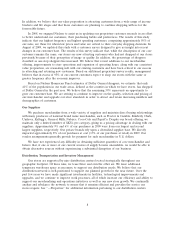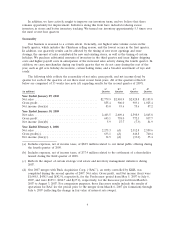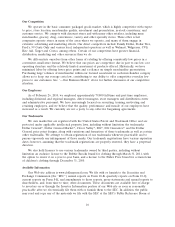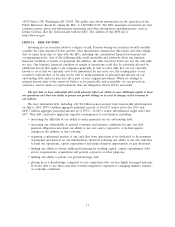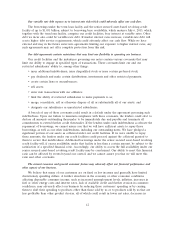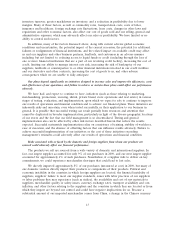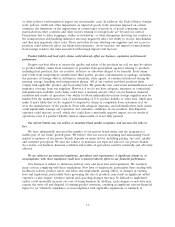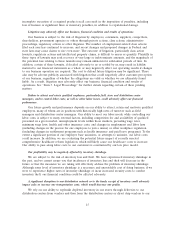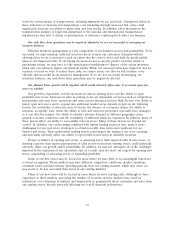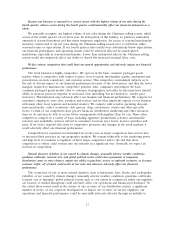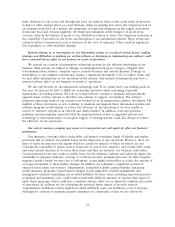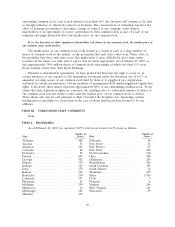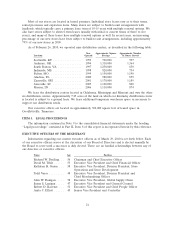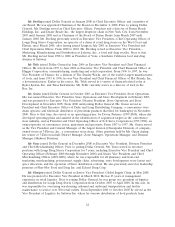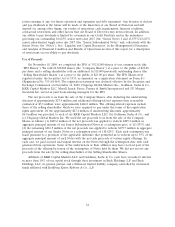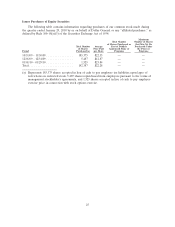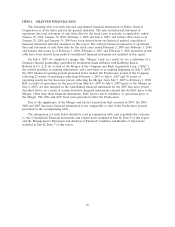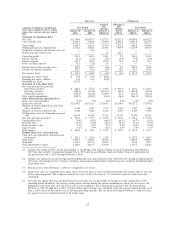Dollar General 2009 Annual Report Download - page 28
Download and view the complete annual report
Please find page 28 of the 2009 Dollar General annual report below. You can navigate through the pages in the report by either clicking on the pages listed below, or by using the keyword search tool below to find specific information within the annual report.Because our business is seasonal to a certain extent, with the highest volume of net sales during the
fourth quarter, adverse events during the fourth quarter could materially affect our financial statements as a
whole.
We generally recognize our highest volume of net sales during the Christmas selling season, which
occurs in the fourth quarter of our fiscal year. In anticipation of this holiday, we purchase substantial
amounts of seasonal inventory and hire many temporary employees. An excess of seasonal merchandise
inventory could result if our net sales during the Christmas selling season were to fall below either
seasonal norms or expectations. If our fourth quarter sales results were substantially below expectations,
our financial performance and operating results could be adversely affected by unanticipated
markdowns, especially in seasonal merchandise. Lower than anticipated sales in the Christmas selling
season would also negatively affect our ability to absorb the increased seasonal labor costs.
We face intense competition that could limit our growth opportunities and adversely impact our financial
performance.
The retail business is highly competitive. We operate in the basic consumer packaged goods
market, which is competitive with respect to price, store location, merchandise quality, assortment and
presentation, in-stock consistency, and customer service. This competitive environment subjects us to
the risk of adverse impact to our financial performance because of the lower prices, and thus the lower
margins, required to maintain our competitive position. Also, companies operating in the basic
consumer packaged goods market (due to customer demographics and other factors) may have limited
ability to increase prices in response to increased costs (including, but not limited to, vendor price
increases). This limitation may adversely affect our margins and financial performance. We compete for
customers, employees, store sites, products and services and in other important aspects of our business
with many other local, regional and national retailers. We compete with retailers operating discount,
mass merchandise, outlet, warehouse club, grocery, drug, convenience, variety and other specialty
stores. Certain of our competitors have greater financial, distribution, marketing and other resources
than we do and may be able to secure better arrangements with suppliers than we can. These other
competitors compete in a variety of ways, including aggressive promotional activities, merchandise
selection and availability, services offered to customers, location, store hours, in-store amenities and
price. If we fail to respond effectively to competitive pressures and changes in the retail markets, it
could adversely affect our financial performance.
Competition for customers has intensified in recent years as larger competitors have moved into,
or increased their presence in, our geographic markets. We remain vulnerable to the marketing power
and high level of consumer recognition of these larger competitors and to the risk that these
competitors or others could venture into our industry in a significant way. Generally, we expect an
increase in competition.
Natural disasters (whether or not caused by climate change), unusually adverse weather conditions,
pandemic outbreaks, terrorist acts, and global political events could cause permanent or temporary
distribution center or store closures, impair our ability to purchase, receive or replenish inventory, or decrease
customer traffic, all of which could result in lost sales and otherwise adversely affect our financial
performance.
The occurrence of one or more natural disasters, such as hurricanes, fires, floods, and earthquakes
(whether or not caused by climate change), unusually adverse weather conditions, pandemic outbreaks,
terrorist acts or disruptive global political events, such as civil unrest in countries in which our suppliers
are located, or similar disruptions could adversely affect our operations and financial performance. To
the extent these events result in the closure of one or more of our distribution centers, a significant
number of stores, or our corporate headquarters or impact one or more of our key suppliers, our
operations and financial performance could be materially adversely affected through an inability to
17



